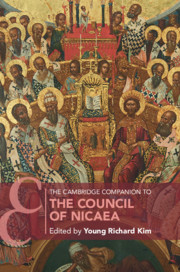Book contents
- The Cambridge Companion to the Council of Nicaea
- Cambridge Companions to Religion
- The Cambridge Companion to the Council of Nicaea
- Copyright page
- Dedication
- Contents
- Figures
- Contributors
- Acknowledgements
- Abbreviations
- 1 Introduction
- Part I Contexts
- Part II The Council
- Part III Outcomes
- Part IV The Aftermath
- 11 The Reception of Nicaea and Homoousios to 360
- 12 The Emergence of the Pro-Nicene Alliance
- 13 Apollinarius and the Nicene Homoousion
- 14 The Council of Ariminum (359) and the Rise of the Neo-Nicenes
- Part V The Long Reception
- Appendices
- Bibliography
- Index
- References
12 - The Emergence of the Pro-Nicene Alliance
from Part IV - The Aftermath
Published online by Cambridge University Press: 17 December 2020
- The Cambridge Companion to the Council of Nicaea
- Cambridge Companions to Religion
- The Cambridge Companion to the Council of Nicaea
- Copyright page
- Dedication
- Contents
- Figures
- Contributors
- Acknowledgements
- Abbreviations
- 1 Introduction
- Part I Contexts
- Part II The Council
- Part III Outcomes
- Part IV The Aftermath
- 11 The Reception of Nicaea and Homoousios to 360
- 12 The Emergence of the Pro-Nicene Alliance
- 13 Apollinarius and the Nicene Homoousion
- 14 The Council of Ariminum (359) and the Rise of the Neo-Nicenes
- Part V The Long Reception
- Appendices
- Bibliography
- Index
- References
Summary
This chapter narrates the emergence of the pro-Nicene alliance by arguing that it was a consensus-building movement. It begins by tracing the history of other consensus-building movements in the fractured theological landscape of the years 325-61 in order to demonstrate their development of various consensus-building tactics, which were ultimately used unsuccessfully. The impetus for the pro-Nicene alliance itself was dissatisfaction with, or the failure of, these previous efforts. Pro-Nicenes adopted four tactics of previous consensus-building efforts and deployed them successfully: (1) defining itself as the center between extreme positions, (2) promoting a minimalist creed that nonetheless ruled out extremes to be avoided, (3) acknowledging that the meaning of a creed was not self-evident and producing supplementary material to insure its correct interpretation, and (4) securing imperial patronage. The chapter then turns to shifts in thinking which occurred in the early 360s and made consensus between former opponents possible, taking Athanasius of Alexandria and Basil of Caesarea as paradigmatic examples of these shifts. The chapter concludes by narrating the consolidation and ascendency of the pro-Nicene alliance in the late 370s and early 380s.
Keywords
- Type
- Chapter
- Information
- The Cambridge Companion to the Council of Nicaea , pp. 256 - 281Publisher: Cambridge University PressPrint publication year: 2021

